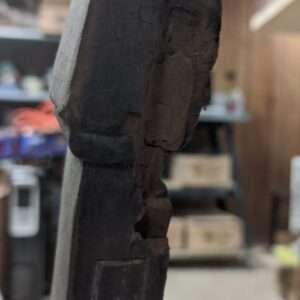Repair rot & worm damage to antique chair.
I am restoring 4 chairs that belonged to the grandmother of a good friend. One foot has significant damage from water and insects. The damage is like the wood turned to soft dust.
I would like to retain as much of the original as I can. Trying to avoid cutting off part of the leg and making new. Just for authenticity sake. Can you recommend what is best? Is the “Bondo” product good? Stainable? Or is there another product you recommend.
















Replies
Many ways to do this. Hard to tell what's best with that picture. I don't think anything is going to ever look original or not be an obvious repair with a fairly rotted out foot.
Easiest is to build/ cast up with epoxy of some sort. Probably drilling out and putting a steel rod in the leg.
Harder but probably better to copy the rotten section and then attach it with a rod down the center again.
Color matching is a restoration skill all to itself. Depending on the option you may almost be faux painting the repaired section to make it match.
post a photo of an intact foot also to give us an idea of what's missing.
Nothing that will harden up that old soft wood, will be stainable.
The Bondo product is fine if the thing's gonna be painted, but at that point, I'd just suggest cutting back to good wood and making a new foot. Actually, I am not so sure the Bondo would really be structurally sound/strong enough to be a chair foot.
If staining, I think your only real answer is to make a new foot as well.
If you're looking for epoxy and not wood, you may try Abatron's WoodEpox. It's a two part epoxy putty that is structural and works nicely with woodworking tools. By way of example, I've used it to rebuild parts of posts in a post and beam house where I couldn't access enough to rebuild with new wood and have used it on rotten window frames after using their liquid wood to consolidate rot. They tell you to leave all the rot and dust! I've not tried to stain WoodEpox with a liquid stain, but it takes paint and gel stain. If you want to accelerate the drying time of the liquid wood, cut it with MEK. Hope this helps.
Nothing takes structural strain on furniture more than the bottom of a chair leg. I'm with FiveBirds. Bondo, epoxy, or any other kind of filler are bound to fail on a chair leg. The only fix I'd want to do is an amputation and a new foot. You are also much more likely do get it to blend in visually with wood than a filler.
I would solidify the joint with glue or flexible epoxy from west system. Add a Dutchman where necessary. A Dutchman will Ensure the ability to stain with uniformity. Layering the color is your best option.
This forum post is now archived. Commenting has been disabled